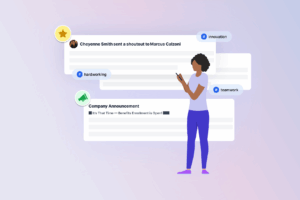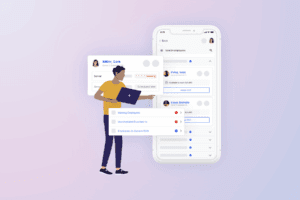Share
Whether new hires or tenured workers, all employees need to be supported through HR management and HR technology. Employee Lifecycle Management recognizes this difference between employees at different stages. Make sure your company is meeting the needs of employees at each phase of their journey.
Discover why employee lifecycle management is so important and how the HR department can do it the right way.
What is the employee lifecycle?
The employee lifecycle is an HR-focused blueprint that maps out the various stages a company’s employee progresses through an organization. While many departments and leaders play a role in this progression, HR is the most critical in its development, monitoring, and execution of the employee lifecycle plan.
Think of it like this… we all remember the lifecycle of a butterfly from elementary school. Caterpillars eat leaves, build a chrysalis, and eventually metamorphose into butterflies. Like a caterpillar, new hires take time and care to grow into their final forms.
New hires gobble up tons of information and training material during onboarding. Eventually, you want them to metamorphose into productive butterflies, adapted and prepared for their unique role in the workplace. The employee lifecycle makes sure that employees are supported at each unique stage of their development.
Why is employee lifecycle management important?
Employee lifecycle management helps to determine and guide each employee’s path within your organization. Maintaining an employee lifecycle’s progress is crucial because it provides a consistent plan to follow throughout their career with the company.
Employee lifecycle management recognizes that each phase of employee development has unique needs.
- Onboarding is just the start.
- Training is key early and often.
- Continuous learning develops employee skills.
- Performance Management sets goals and monitors progress.
- Even offboarding employees is a critical step.
HR technology enables employers to assign, track, and monitor data of various HR processes over time, as well as gives employees insight into their personal performance and progress through employee self-service portals.
What are the stages of the employee lifecycle?
Attraction
A positive branding strategy draws the right kind of attention to your company from multiple angles. During the attraction phase of the employee lifecycle, you aren’t necessarily recruiting for a specific job opening. Even when you aren’t hiring, your branding should generate buzz to cast the company in a flattering light and make people want to work there.
Recruitment
When positions come open, make sure you’re sending the right message to candidates. If you’ve handled the “attraction” phase well, then potential applicants should already have a positive view of your company. Keep the recruiting message simple and positive, but detailed to relay important job requirements.
Onboarding
Once you’ve caught the attention of the right applicants and made your selection, you can funnel them into your web-based employee portals. Use background checks and check references before fully committing. You can also begin virtual onboarding online, even before new hires visit the office in person. New hires have different needs from long term employees, and catering to those specific needs will help them adapt to the new environment.
Development
It’s obvious that new hires need training and attention. But don’t forget about the rest of your employees. They all require unique attention, even those who have been at your company forever. Everyone wants to be successful in their careers, but success looks very different from one person to the next. Use a Learning Management System to promote continuous learning and give employees a chance to cross train in new skills.
Retention
How do you recognize and reward high performers, or motivate and elevate underperforming workers? Performance Management software lets you automatically collect and compare employee reviews and other data. Reward your best employees, and give the others concrete metrics for where they can improve.
Additionally, HR is tasked with keeping employees comfortable, informed, stimulated, and happy. Nothing helps retention better than employees that are happy and fulfilled.
Offboarding
Offboarding is just as important as onboarding. Think about the unique needs of departing employees, and remember that your company still has specific needs from them. Your former employees will serve as brand ambassadors in your community. Develop an offboarding checklist to make a good final impression and take advantage of their candid feedback on your company culture.
What are the benefits of proper employee lifecycle management?
Increases employee engagement & satisfaction
Everyone wants to be treated with respect, and nearly everyone wants to feel like they’re doing productive and meaningful work. Employee lifecycle management empowers your team with the relevant support and opportunities to succeed in their careers.
With uniformed and unsatisfied workers, there might be some who are content to coast on by, or more likely, search for employment elsewhere—bringing down fellow employees and negatively affecting your workplace culture.
Nurtures skill development in your employees
If you fail to address the different lifecycle stages of employees, then your training resources can be a hindrance rather than a help. New hires need to focus on learning the essentials of their current position, not expanding their portfolio to apply with another company.
The workers who struggle to meet expectations may need to close skill gaps, but they probably don’t need to cross train or develop new management skills. It’s great to promote continuous learning, but those opportunities and incentives need to match the circumstances of each worker.
Increases employee retention
Employees want to feel like they are improving and growing professionally. Provide employees with new opportunities at each stage of their lifecycle. Personal growth can be a big incentive without much added expense, making your company more attractive as an employer.
Employee engagement and satisfaction are also significant factors in retention. Happy employees make long-standing relationships. HR is tasked with keeping employees comfortable, informed, stimulated, and happy.
Improves your ability to recruit quality talent
Give special attention to each phase of the hiring process: attraction, recruiting, and onboarding. Consider the different needs and priorities of potential employees at each stage of their lifecycle.
When you leverage a Learning Management System for employees to continuously grow their careers, that becomes a major benefit for motivated workers. An engaged and fulfilled workforce will have a noticeably more energized company culture, attracting new applicants who appreciate that kind of positivity.
Provides structure to your training
When your training sessions are conveniently digitized, it’s easy to overwhelm employees. Keep the material well organized and selectively grant access to the material that’s most relevant for the employee’s current status.
Likewise, employees who are still mastering their current role may need direction and supervision in their ongoing training. Successful employees can be rewarded with additional opportunities as a way to encourage retention, but those additional opportunities won’t feel like a reward if they’ve been accessible the whole time.
Creates lasting relationship with employees
Although often overlooked, offboarding employees is an important part of the employee lifecycle. Avoiding this critical last step could leave departing employees feeling unappreciated and disillusioned.
Former employees can be major brand ambassadors for your company, providing high-quality customer or employee referrals . Some may even return to your company as boomerang employees with added skills and insights will be helpful to the company.
Industry news & tips sent straight to your inbox!
Enter your email below to subscribe to industry news, product updates, and tips.
For more information on HR topics, read our HR blog and follow Netchex on social media—Facebook, LinkedIn, and Twitter.
Related articles

Introducing HR Reporting with AI that Can Actually Impact Your Bottom Line

The Real ROI of Streamlining HR and Payroll

Tasks & Workflows: Innovating Automation for HR

